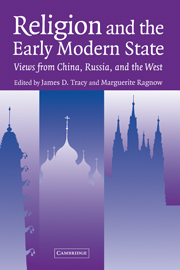Book contents
- Frontmatter
- Contents
- Contributors
- Acknowledgments
- Preface
- Religion and the Early Modern State
- Introduction
- PART I LIVED RELIGION AND OFFICIAL RELIGION
- PART II FORMS OF RELIGIOUS IDENTITY
- 5 Spirits of the Penumbra: Dieties Worshiped in More Than One Chinese Pantheon
- 6 Orthodoxy and Revolt: The Role of Religion in the Seventeenth-Century Ukrainian Uprising against the Polish-Lithuanian Commonwealth
- 7 The Huguenot Minority in Early Modern France
- 8 State Religion and Puritan Resistance in Early Seventeenth-Century England
- PART III THE SOCIAL ARTICULATION OF BELIEF
- AN EPILOGUE AT THE PARISH LEVEL
- Selected Annotated Bibliography of Secondary Works
- Index
5 - Spirits of the Penumbra: Dieties Worshiped in More Than One Chinese Pantheon
Published online by Cambridge University Press: 23 May 2010
- Frontmatter
- Contents
- Contributors
- Acknowledgments
- Preface
- Religion and the Early Modern State
- Introduction
- PART I LIVED RELIGION AND OFFICIAL RELIGION
- PART II FORMS OF RELIGIOUS IDENTITY
- 5 Spirits of the Penumbra: Dieties Worshiped in More Than One Chinese Pantheon
- 6 Orthodoxy and Revolt: The Role of Religion in the Seventeenth-Century Ukrainian Uprising against the Polish-Lithuanian Commonwealth
- 7 The Huguenot Minority in Early Modern France
- 8 State Religion and Puritan Resistance in Early Seventeenth-Century England
- PART III THE SOCIAL ARTICULATION OF BELIEF
- AN EPILOGUE AT THE PARISH LEVEL
- Selected Annotated Bibliography of Secondary Works
- Index
Summary
INTRODUCTION: CHINESE ORTHODOXY
In his contribution to this volume, Professor Richard Shek has illuminated the “alternative moral universe” of the Eternal Mother sects, a universe made by dissenters from a “Chinese orthodoxy” that he defines as the “doctrine of propriety-and-ritual” (lijiao). Under their religious aspect, the rites of the lijiao were understood to have been an expression of the will of Heaven and its correct performance was necessary for the maintenance of social and cosmic harmony. The sociopolitical content of the lijiao is reduced to its core, the “three bonds” (sangang), which were the paradigmatic relationships between subject and ruler, child and parents, and wife and husband.
In what follows, I turn from Professor Shek's “alternative moral universe” to look at the other term of his polarity – “Chinese orthodoxy.” I start from the assumption of a Chinese social whole, and I understand the social whole under its religious aspect as a hierarchically ordered system comprising four distinct religions (each with its own evolving orthodoxy). These were, first, the legally prescribed official religion of the empire, followed in rank order by Buddhism and Daoism (both of which were quasi-legal, i.e., accommodated and regulated, but not mandated by the law), and, finally, the diffuse popular religion that was embedded in the “natural” communities of village, neighborhood, and household.
- Type
- Chapter
- Information
- Religion and the Early Modern StateViews from China, Russia, and the West, pp. 121 - 153Publisher: Cambridge University PressPrint publication year: 2004
- 2
- Cited by



